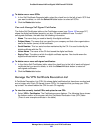
Network and System Management
328
ProSafe Wireless-N 8-Port Gigabit VPN Firewall FVS318N
Use QoS and Bandwidth Assignment to Shift the Traffic Mix
By setting the QoS priority and assigning bandwidth profiles to firewall rules, you can shift the
traffic mix to aim for optimum performance of the wireless VPN firewall.
Set QoS Priorities
The QoS priority settings determine the Quality of Service for the traffic passing through the
wireless VPN firewall. You can assign a QoS priority to LAN WAN and DMZ WAN outbound
firewall rules. The QoS is set individually for each firewall rule. You can change the mix of
traffic through the WAN ports by granting some services a higher priority than others:
• Y
ou can accept the default priority defined by the service itself by not changing its QoS
priority.
• Y
ou can change the priority to a higher or lower value than its default setting to give the
service higher or lower priority than it otherwise would have.
For more information about QoS profiles, see Preconfigured Quality of Service Profiles on
page 177.
Assign Bandwidth Profiles
When you set the QoS priority, the WAN bandwidth does not change. You change the WAN
bandwidth that is assigned to a service or application by applying a bandwidth profile to a
LAN WAN inbound or outbound rule. The purpose of bandwidth profiles is to provide a
method for allocating and limiting traffic, thus allocating LAN users sufficient bandwidth while
preventing them from consuming all the bandwidth on your WAN links.
For more information about bandwidth profiles, see Create Bandwidth Profiles on p
age 175.
Monitoring Tools for Traffic Management
The wireless VPN firewall includes several tools that can be used to monitor the traffic
conditions of the firewall and content-filtering engine and to monitor the users’ access to the
Internet and the types of traffic that they are allowed to have. See Chapter 10, Monitor
System Access and Performance, for a description of these tools.


















